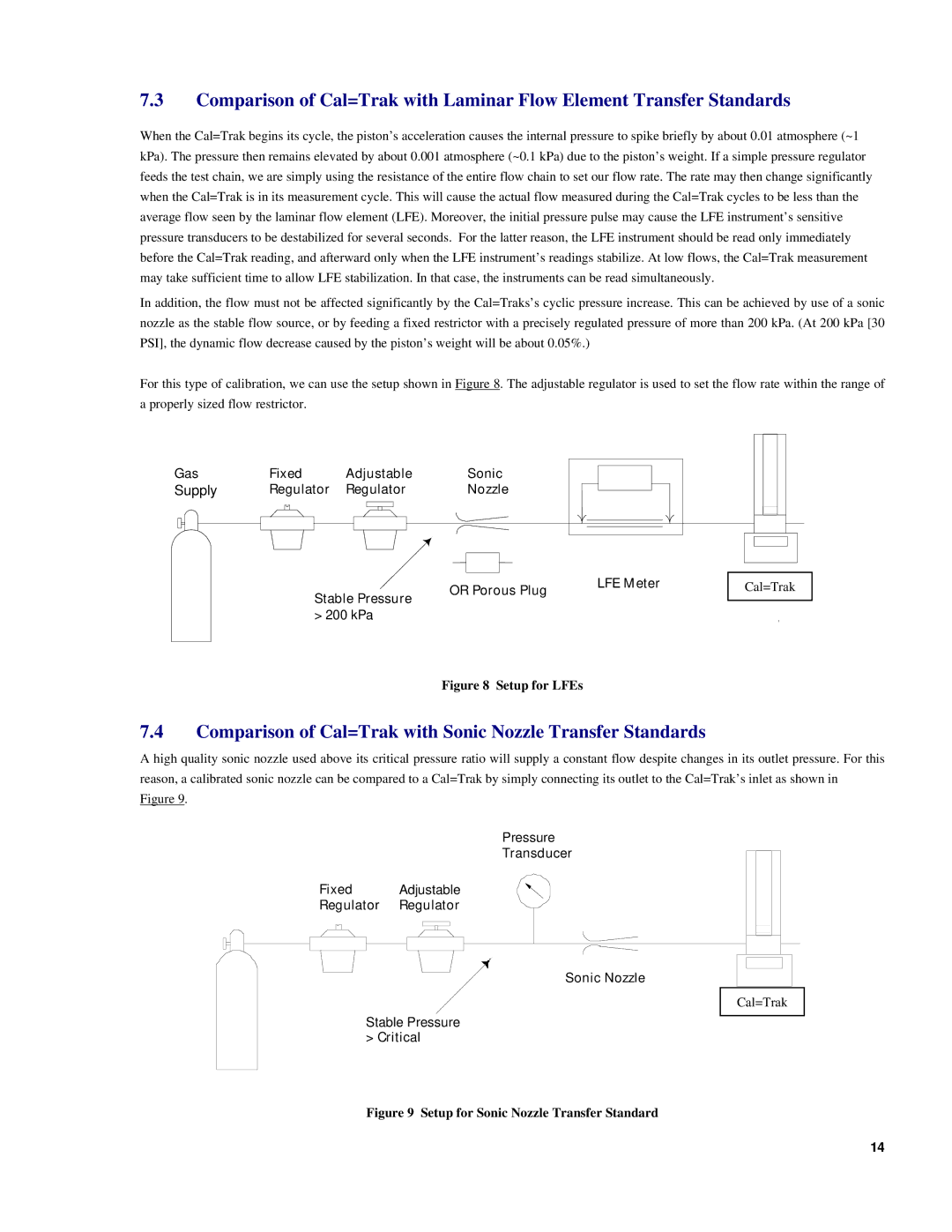
7.3Comparison of Cal=Trak with Laminar Flow Element Transfer Standards
When the Cal=Trak begins its cycle, the piston’s acceleration causes the internal pressure to spike briefly by about 0.01 atmosphere (~1 kPa). The pressure then remains elevated by about 0.001 atmosphere (~0.1 kPa) due to the piston’s weight. If a simple pressure regulator feeds the test chain, we are simply using the resistance of the entire flow chain to set our flow rate. The rate may then change significantly when the Cal=Trak is in its measurement cycle. This will cause the actual flow measured during the Cal=Trak cycles to be less than the average flow seen by the laminar flow element (LFE). Moreover, the initial pressure pulse may cause the LFE instrument’s sensitive pressure transducers to be destabilized for several seconds. For the latter reason, the LFE instrument should be read only immediately before the Cal=Trak reading, and afterward only when the LFE instrument’s readings stabilize. At low flows, the Cal=Trak measurement may take sufficient time to allow LFE stabilization. In that case, the instruments can be read simultaneously.
In addition, the flow must not be affected significantly by the Cal=Traks’s cyclic pressure increase. This can be achieved by use of a sonic nozzle as the stable flow source, or by feeding a fixed restrictor with a precisely regulated pressure of more than 200 kPa. (At 200 kPa [30 PSI], the dynamic flow decrease caused by the piston’s weight will be about 0.05%.)
For this type of calibration, we can use the setup shown in Figure 8. The adjustable regulator is used to set the flow rate within the range of a properly sized flow restrictor.
Gas | Fixed | Adjustable | Sonic | ||||||||||||
Supply | Regulator | Regulator | Nozzle | ||||||||||||
|
|
|
|
|
|
|
|
|
|
|
|
|
|
|
|
|
|
|
|
|
|
|
|
|
|
|
|
|
|
|
|
|
|
|
|
|
|
|
|
|
|
|
|
|
|
|
|
|
|
|
|
|
|
|
|
|
|
|
|
|
|
|
|
|
|
|
|
|
|
|
|
|
|
|
|
|
|
|
|
Stable Pressure | OR Porous Plug | LFE Meter |
| ||
|
| |
> 200 kPa |
|
|
Figure 8 Setup for LFEs
DryCal
Cal=Trak
7.4Comparison of Cal=Trak with Sonic Nozzle Transfer Standards
A high quality sonic nozzle used above its critical pressure ratio will supply a constant flow despite changes in its outlet pressure. For this reason, a calibrated sonic nozzle can be compared to a Cal=Trak by simply connecting its outlet to the Cal=Trak’s inlet as shown in Figure 9.
Pressure
Transducer
Fixed Adjustable
Regulator Regulator
Sonic Nozzle
Stable Pressure
> Critical
Figure 9 Setup for Sonic Nozzle Transfer Standard
DryCal
Cal=Trak
14
